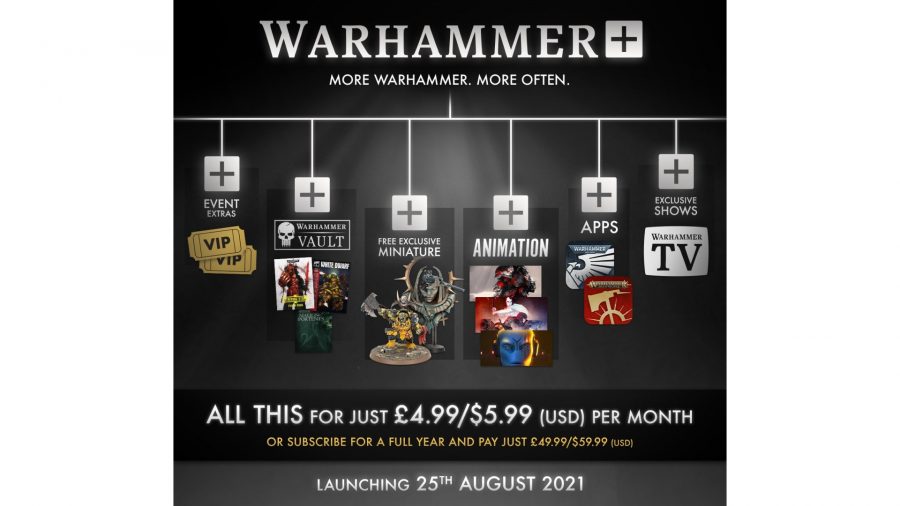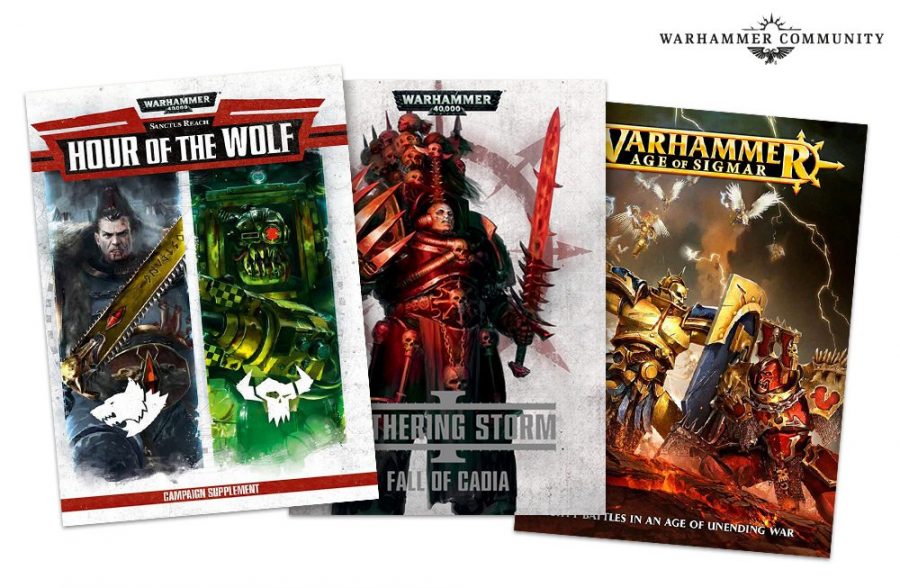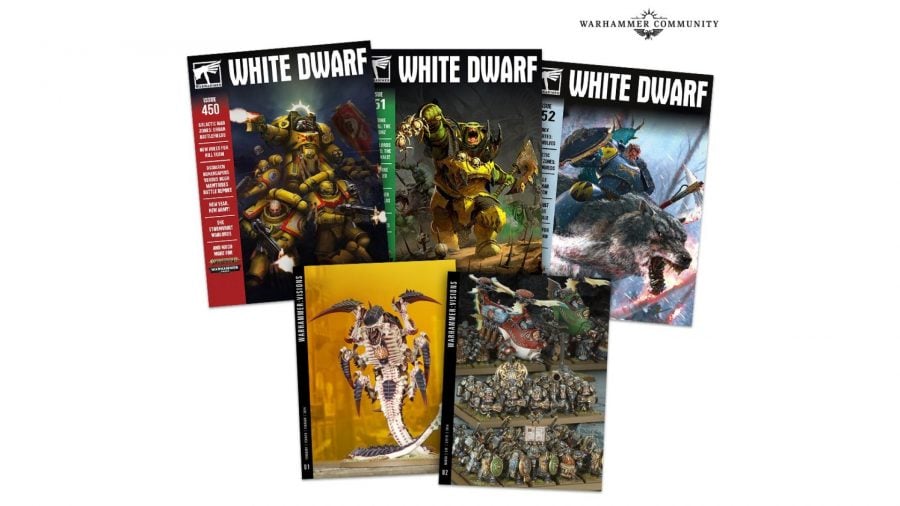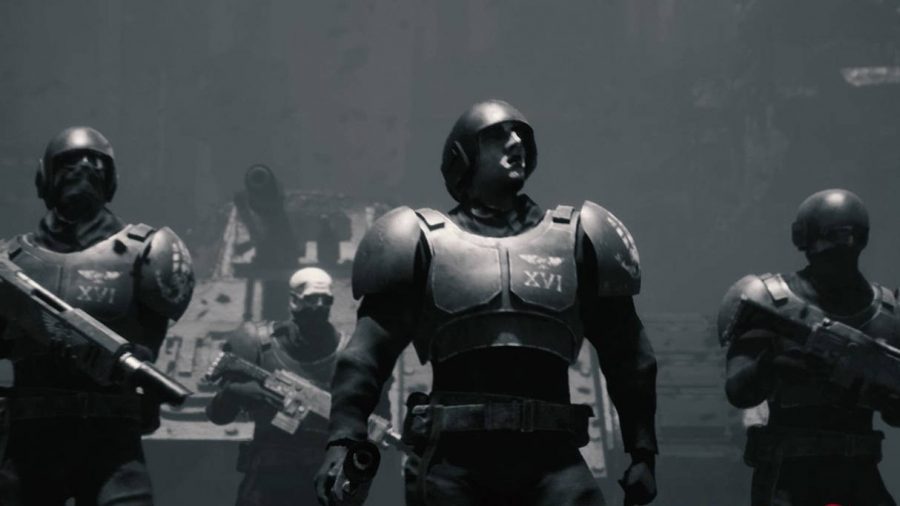Two weeks ago, Games Workshop, the 46-years-young UK company behind the Warhammer 40k and Warhammer Age of Sigmar tabletop wargames (among countless other titles) shouldered its way into an exclusive club, peopled by the likes of Disney, Apple, Amazon, and Netflix: it birthed its very own online streaming service, Warhammer+ (or Warhammer Plus, if you’d rather).
The launch was a bit ramshackle, and a fair portion of Warhammer’s infamously, er, ‘indefatigable’ fan base seems to be rather down on the whole thing (fancy that). As it stands, they’re not complaining over nothing, either – the service is strapped for content, and fraught with issues. For all that, though, I think it’s the most interesting thing to happen to Warhammer in bloody ages. Allow me to explain.
The proposition, as first laid out in June by Warhammer Community, GW’s own digital media marketing operation, was enticing – especially to Warhammer ‘lifers’. A $6 / £5 monthly fee, said GW, got you into its brand new online library of animated and live-action TV series; it got you paid logins to the 40k and Age of Sigmar apps (with access to more digital rules, and list-building tools); it let you read digitised versions of old Warhammer publications from its ‘Vault’; it gave you one free, exclusive Warhammer mini if you stayed paid-up for a year; and it would offer you discount vouchers on GW’s web store.
We hadn’t really known what to expect, but what GW finally unveiled looked to most of us like a pretty good deal.
A messy start
Fast forward to Wednesday, August 25, and Warhammer+’s launch delivered everything GW had promised – in a manner of speaking. The subscription portal on the Warhammer+ website did open, and (if you weren’t stuck in a queue while the servers overloaded) you could sign up. The rolled-in paid subscription to Warhammer 40k and Age of Sigmar apps worked like a charm – except that the much feted, and long delayed, new Age of Sigmar app hadn’t come out yet, wasn’t due to launch for another month, and GW had already pulled all support for its predecessor ‘Azyr’ app.
There was a video streaming site and mobile app, with only a limited starting selection of shows (a fact which GW had, to its credit, been quite upfront about) but the app itself was called Warhammer TV, not Warhammer+, as previously indicated, and did not show up in app store searches for Warhammer+ (on launch day, at least). Even the main Warhammer+ homepage did a strangely poor job of funnelling new subscribers toward the shiny content they’d just signed up for, its real estate dominated by a huge animated graphic, urging people to subscribe.
There was a Warhammer Vault website, on which you could view a bunch of old White Dwarf magazine issues, a couple of written painting guides, and a small selection of 7th and 8th Edition Warhammer 40k lore and rules supplements – but it seemed almost deliberately hidden, with no app of its own, and only accessible through a single, unassuming text link, a long way down that main Warhammer+ page. Even once you’d found your way inside, it turned out the publications within couldn’t be downloaded to read offline – you could only access them in your browser.
Get up close: Read our review of Kill Team: Octarius
It was all very confusing, and, combined with the scant hours of actual video available on day one, whipped up more than a little negativity about the service among the Warhammer crowd.
Warhammer Minus?
Most criticism was muted, and balanced with a healthy optimism about the fundamental value of the scheme – Rob Baer, of veteran Warhammer blog Spikey Bits, encapsulated this in the phrase “we’re not mad, just disappointed” – but some hot takes were more heated.
Most boil down to ‘Warhammer, as a hobby, is already expensive, and I don’t want to pay GW even more money’ – and hey, it’s hard not to sympathise with that. Similarly, folks who simply don’t want to tally yet another subscription fee into their monthly outgoings have got a strong point; lots of consumers already feel their life is saturated with $6-a-month signups, and it makes sense for some to be pissed off at having to tack on another monthly fee.
Other viewpoints are less hooked up to reality. Some web-dwelling Warhammerers prophesied the service’s early demise in Reddit threads as early as May, before the launch line-up had even been announced, predicting it would burn out rapidly, due to subscriber flight and widespread pirating of its content. Time will tell, of course, but I’d lay a heavy bet on these guys not being proven right.
The most bizarre I have yet seen, in a social media comment on one of our articles on the subject, confidently declared something along the lines of: ‘you and I both know it’ll all be up on YouTube in a matter of weeks’. Such people are presumably oblivious, both to the long-haul financial confidence GW must have placed behind Warhammer+ for it to get this far, and to the firm’s new level of seriousness about locking down uses of its intellectual property.
Goldishocks: Read our Warhammer 40k Adeptus Custodes guide
And some, of course, rankled at having to pay anything at all for this stuff, after years getting to consume third party creators’ meticulously-built passion projects online, without handing anyone a dime. A large portion of the Warhammer community seems determined to see 40k, Age of Sigmar, and GW’s other assorted games and associated media, as a massive, open-source community project – and consequently resents every move by GW to make money from the things it legally owns, instead of making them available for free. To me, it’s a bit like the folks who resented the triumph of Spotify over LimeWire; they can see the encroaching claws of capitalist ownership coming, and cling desperately to their ever-shrinking patch of Internet wild west.
A waiting game
But all these various arguments and critiques invariably end up terminating, like so many scraps over the pluses and minuses of some new gaming doodad, in that familiar old cul-de-sac: ‘if you don’t like it, don’t buy it’. In the specific context of Warhammer+ and the most legitimate quibble people have with it – the severely limited total runtime of its current video library – we can amend this to: ‘if you don’t like it, don’t buy it yet’.
I haven’t substantively ‘reviewed’ Warhammer+ for Wargamer, because I don’t think there’s enough there, in its current state, to meaningfully represent what the product will be for the majority of its lifetime. To some, that’s evidence that GW was reckless or exploitative of its dedicated fans to release Warhammer+ in the condition it did, and fits into a broader pattern of ramping up monetisation of its most committed customers. To most people, though, it’s a reminder that – for now, and for them – Warhammer+ just isn’t really a big deal. So it’s not got much content yet and the apps don’t work that well? That’s fine, just don’t subscribe till there’s more content, and stuff works better. Sorted. What’s for lunch?
Whatever your misgivings about GW and its nefarious plans to sell you things, you still have the choice of when, or if, to buy your ticket on the Warhammer+ train. For lots of people, now ain’t the right time, and that’s fine.
Raise the dead: Our Age of Sigmar Soulblight Gravelords guide
You can keep an eye on it, with the help of your friendly neighbourhood Wargamer.com, and steer clear if you feel like it. But don’t write off getting on the train completely – because that train is going places.
The (grimdark) future’s bright
The advantage of a subscription scheme is being able to offer a variety of stuff at a reduced total price to each customer, because you’re able to count on many more repeated smaller payments, from a larger total number of people, for more predictable revenues overall.
Purely on the basis of app costs, for many players of both GW’s main wargames, Warhammer+ will soon already offer that saving (as soon as the new Age of Sigmar app launches). That’s mostly because both apps were absurdly overpriced to begin with, but the fact remains that the keenest players will save money and get a bunch of TV to watch, plus other extras. Hypotheticals aside, for most of Warhammer’s core following, Warhammer+ is literally a no-brainer.
But, in my mind, the service, as it’s currently available, is by far the least interesting part of the Warhammer+ story. The really exciting thing in all this is that there’s finally the beginning of a business model to digitise Warhammer, top to bottom; tooth and claw.
Only in the last two years has GW finally dipped its toe properly into the warm pool of managing its games digitally, by launching the Warhammer 40k app, and putting codes in the inside covers of each new codex rulebook to access its rules content digitally within the app. On the whole, it’s been a success, purely by reducing the number of massive books players have to lug around.
But it’s only halfway to a proper digital solution: it’s a lacklustre, underfunded app, providing imperfect digital access to part of an obscenely expensive physical book that you still have to buy in order to play, and which will still become obsolete in three years’ time when it’s replaced with a new edition. As Warhammer’s player base grows, producing high-quality, hardback codexes that simultaneously please people who love narrative, and people who just want the new rules, at anything even close to a sensible price, has become increasingly unachievable.
Foul play: Read our guide to Warhammer 40k’s Death Guard army
The underlying promise of Warhammer+ is that, by virtue of a bigger pool of subscription revenues, and a digital platform that can attract new Warhammer fans (as opposed to mere mobile-app player aids for existing players) GW will finally be able to make all its game rules fully available online, in their own system, that actually works, and, in fact, gives fans more flexible ways to buy its content.
The printed books will still be there, but they’ll no longer have to compromise on their lore and narrative elements to accommodate ever-growing unit lists, and rules for different gameplay modes. Dungeons and Dragons managed this with D&D Beyond, and sure, it took a few years to get right, but these days it’s a superb template for others, like GW, to follow. I hope it does.
On top of that, the community implications of a proper, well-managed, constantly expanding digital platform for Warhammer content, run with the money, expertise, and support of the people that actually make the damn plastic soldiers, are gigantic.
New players will have a clear, curated, official one stop shop to introduce each game, learn to play in their own time, and generally gain a grounding in Warhammer’s worlds, instead of having to find their own way through the web’s thick jungle of independent videos, message boards, and online communities. While that jungle is undoubtedly home to legendary, wonderful creators and groups that nurture newbies (the likes of Tabletop Tactics, WintersSEO, and Midwinter Minis come to mind), it can also be replete with negativity, confusion, hostility, and toxicity – especially if you happen not to be a young, white, straight, cis male.
Owning their own subscription platform opens the doors for GW to follow D&D Beyond’s example in offering new digital interactions, as well as just a medium for packaging selling digital rules content: user profiles, personalisation, user discussion and tactics forums, interactive game and scenario tools; heck, even customisable digital dice rollers – it’s all on the table, and more besides. If Wizards of the Coast can do it, GW can.
Warhammer 40k has been around since 1987, and Warhammer Fantasy Battle (the precursor to Age of Sigmar) since 1983. For most of that time, big, fundamental changes to how the games and hobbies are bought, accessed, and played have come about very slowly and cautiously. For most of that time – even since the advent of smartphones – both games have remained almost completely reliant on buying multiple expensive rulebooks, and carrying them with you to every game. One way or another, that has to change, and soon.
Row your boat: Our guide to Roboute Guilliman’s Ultramarines
For now, Warhammer+ is a $6-a-month subscription service that buys you access to a functioning, but barebones, video streaming site with about 30 hours of content on it; one sort-of-ok 40k rules app; and a fairly underwhelming, browser-based PDF viewer for a handful of old magazines. The future, however, is a very different game of soldiers.










